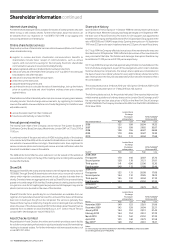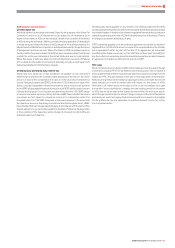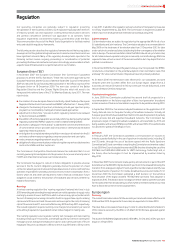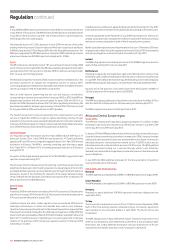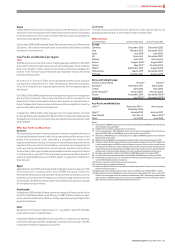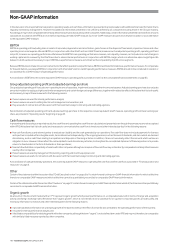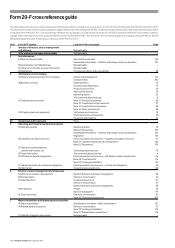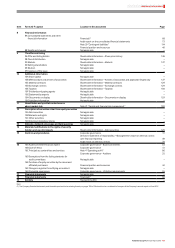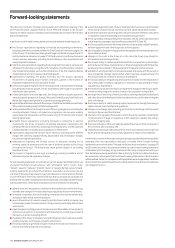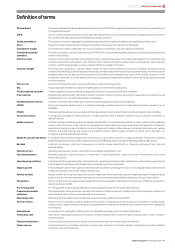Vodafone 2010 Annual Report Download - page 135
Download and view the complete annual report
Please find page 135 of the 2010 Vodafone annual report below. You can navigate through the pages in the report by either clicking on the pages listed below, or by using the keyword search tool below to find specific information within the annual report.
Vodafone Group Plc Annual Report 2010 133
Additional information
Our operating companies are generally subject to regulation governing
the operation of their business activities. Such regulation typically takes the form
of industry specific law and regulation covering telecommunications services
and general competition (antitrust) law applicable to all activities. Some
regulation implements commitments made by governments under the Basic
Telecommunications Accord of the World Trade Organisation to facilitate market
entry and establish regulatory frameworks.
The following section describes the regulatory frameworks and the key regulatory
developments at the global and regional level and in selected countries in which we
have significant interests. Many of the regulatory developments reported in the
following section involve ongoing proceedings or consideration of potential
proceedings that have not reached a conclusion. Accordingly, we are unable to attach
a specific level of financial risk to our performance from such matters.
European Union (‘EU’)
In November 2007 the European Commission (the ‘Commission’) published
proposals to amend the EU framework. These new rules were approved by the
European Parliament and the Council of Member States (the ‘Council’) in November
2009 and became EU law following their publication in the Official Journal of the
European Union on 18 December 2009. The new rules consist of the Better
Regulation Directive and the Citizens’ Rights Directive which will need to be
transposed into national laws of the 27 EU Member States by June 2011. The new
rules include:
the creation of a new European Telecoms Authority called the Body of European
Regulators for Electronic Communications (‘BEREC’) effective from 7 January 2010;
changes to the licensing of spectrum, introducing a multi-year spectrum policy
programme, more flexibility, trading and market-based approaches;
adjustments to the Article 7 process in which regulatory decisions are reviewed
by the Commission and BEREC;
the addition of functional separation as a remedy which may be imposed by national
regulatory authorities (‘NRAs’) subject to certain conditions being fulfilled;
provisions to safeguard “net neutrality” to address the concerns that the services
of some internet service providers will be blocked or otherwise discriminated
against by network operators;
an obligation to complete number portability in one day on all networks in the EU
and various other measures regarding consumer protection and user rights;
various measures regarding network security; and
obligations for telecommunication providers to register any serious data breaches
and to inform NRAs and their customers.
The Commission’s Competition Directorate General has indicated that it is not
currently pursuing its investigation into the provision of voice over internet protocol
(‘VOIP’) and other internet services over mobile networks.
The Commission has begun to consult on future obligations to provide universal
services in the EU. Current obligations generally involve the provision of a fixed
connection allowing access to voice and simple data services. In some countries those
operators responsible for providing universal services receive compensation from a
fund to which we and others are required to make a financial contribution. Future
obligations could extend to the provision of broadband data services, whether by
mobile or fixed means.
Roaming
A revised roaming regulation (the ‘roaming regulation’) entered into force in July
2009 amending and extending the requirements on mobile operators to supply voice
roaming by means of a euro-tariff (from which customers may opt out) under which
the cost of making and receiving calls within the EU is capped. New caps for making
calls are set at 39 eurocents and 35 eurocents and new caps for the costs of receiving
calls at 15 eurocents and 11 eurocents effective July 2010 and July 2011 respectively.
The revised regulation requires roaming voice charges to be levied in per second
units although operators may establish certain initial charges for making calls.
The roaming regulations also regulate roaming text messages and data roaming
including a retail cap of 11 eurocents, a wholesale cap of 4 eurocents on roaming text
messages and an average wholesale price cap for data roaming services of €1 per
megabyte. This price cap reduces to 80 eurocents in July 2010 and to 50 eurocents
in July 2011. In addition, the regulation sets out a number of transparency measures
to be fully implemented by July 2010. The Commission is required to publish an
interim report on developments in international roaming during 2010.
Call termination
Call termination rates are subject to regulation by the appropriate NRA in all of our
EU subsidiaries and joint ventures. The Commission adopted a recommendation in
May 2009 on the treatment of termination rates from 31 December 2012 (or later
under certain circumstances) aimed at achieving further convergence of termination
rates in Europe. The recommendation states that NRAs should set symmetric rates
for all mobile network operators using an incremental cost methodology. NRAs are
required to take utmost account of the recommendation but may depart from it in
justified circumstances.
In December 2009 the European Regulators Group, now incorporated into BEREC,
conducted a consultation on the potential adoption of zero termination rates (“bill
and keep”) for voice call termination. Responses have not yet been published.
At 31 March 2010 the termination rates effective for our subsidiaries and joint
ventures within the EU, which differs from our Europe region, ranged from 4.3
eurocents per minute (3.9 pence) to 9.0 eurocents per minute (8.0 pence), at the
relevant 31 March 2010 exchange rate.
Fixed network regulation
In June 2009 the Commission published the second draft of proposals for a
recommendation on the future regulation of fibre ‘next generation’ broadband
access networks. A final recommendation is expected to be published during 2010.
In September 2009 the Commission adopted Guidelines on the application of EC
Treaty state aid rules to the public funding of broadband networks. Virtually all
European governments have stated their intent to stimulate the provision of, partially
fund or provide, fast and superfast broadband networks. The Commission has
proposed a target of making broadband available to all households by 2013 and
being available with at least 30 Mbps by 2020, with at least 50% of households able
to subscribe to speeds of 100 Mbps or more.
Spectrum
In February 2007 the Commission published a communication on its plans to
introduce greater flexibility in the use of spectrum in selected bands, including 2G
and 3G bands, through the use of decisions agreed with the Radio Spectrum
Committee (an EU level committee comprising the Commission and member states).
In July 2009 the Council adopted the amended GSM directive allowing the use of the
900 MHz and 1800 MHz GSM bands for UMTS technology (‘refarming’) and, in
the future, other technologies. It must be implemented by member states by
May 2010.
In November 2007 the Commission made a policy announcement on part of the UHF
band known as the 800 MHz ‘digital dividend’ spectrum (to be released following the
transition from analogue to digital TV) and urged the member states to identify new
harmonised bands of spectrum for mobile broadband services and mobile TV. In
December 2009 the Commission published a draft decision on the technical
harmonisation of the digital dividend 790-862 MHz sub-band. Final adoption is
expected in 2010. The decision does not oblige a member state to open the sub-band
for new uses other than broadcasting, but if and when a member state does so, it will
have to follow the common technical parameters.
Europe region
Germany
The current termination rates of 6.59 eurocents per minute will remain effective until
30 November 2010. Proposals for future rates are expected in October 2010.
The rates that access seekers have to pay in order to unbundle Deutsche Telekom’s
VDSL network were set by the NRA on 26 March 2010. We have appealed against
these rates.
The auction for 800 MHz (digital dividend), 1800 MHz, 2.1 GHz and 2.6 GHz spectrum
began on 12 April 2010.
Regulation





